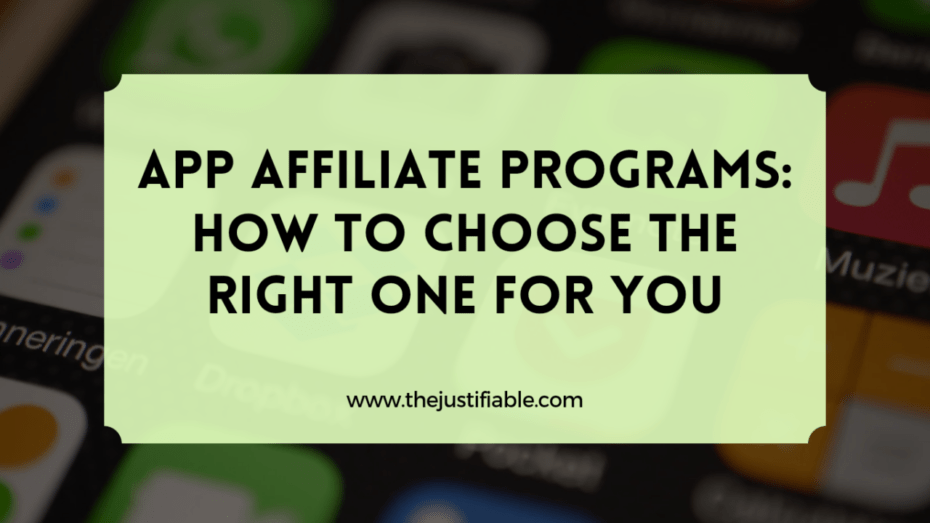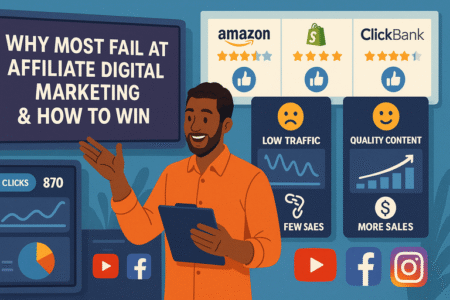Table of Contents
Are you wondering how to start affiliate marketing online and achieve quick success? What strategies can help you kickstart your journey and see results fast?
In this comprehensive guide, we’ll answer these questions and explore actionable tips to help you begin earning as an affiliate marketer.
Understand The Basics Of Affiliate Marketing Online
Affiliate marketing is an excellent way to earn a steady income by promoting products or services online. By understanding its basics, you can confidently start your journey and set a strong foundation for future success.
What Is Affiliate Marketing And How It Works
Affiliate marketing is a performance-based model where individuals promote a company’s products and earn a commission for sales made through their unique referral links. It creates a win-win situation for both affiliates and businesses by combining marketing with revenue sharing.
This model works seamlessly because affiliates act as middlemen, introducing products to potential customers. Businesses save on traditional advertising costs while affiliates profit from their marketing efforts. I recommend this approach for its simplicity and scalability.
Think of it like suggesting your favorite restaurant to a friend; when they dine there, the restaurant thanks you with a reward. That’s essentially how affiliate marketing operates but on a broader scale.
Moreover, affiliates use various platforms like blogs, social media, or email to drive traffic to their referral links. This accessibility makes affiliate marketing a flexible and rewarding venture.
Finally, remember that consistency and transparency are key. Sharing authentic insights about products helps build trust and fosters long-term relationships with your audience.
The Role Of Affiliates In Generating Sales
Affiliates play a pivotal role in bridging the gap between businesses and potential buyers. They create compelling content to showcase the value of products, persuading their audience to make informed purchasing decisions.
Affiliates often share personal experiences, highlighting the benefits of products. This relatability makes it easier for consumers to trust their recommendations and complete purchases confidently.
I suggest affiliates focus on audience engagement to increase conversions. Interacting with your audience, answering their questions, and providing honest feedback are invaluable practices.
Another critical aspect is creating content tailored to the audience’s needs. For example, product reviews, tutorials, and comparisons often resonate with readers, enhancing sales opportunities.
Most importantly, affiliates act as trusted advisors, ensuring customers receive valuable insights before purchasing. This responsibility builds credibility and long-term success.
Benefits Of Choosing Affiliate Marketing For Beginners
Affiliate marketing offers numerous advantages, making it an ideal choice for beginners looking to earn online. Its low entry barrier and flexibility make it accessible to almost anyone with an internet connection.
One significant benefit is the lack of inventory or upfront investment. Unlike traditional businesses, you don’t need to stock products or worry about shipping logistics. This reduces risks and operational headaches.
Additionally, I recommend affiliate marketing for its scalability. As your audience grows, so does your earning potential, allowing you to achieve financial freedom over time.
Flexibility is another key advantage. You can work from anywhere and create content on your terms, making it a perfect side hustle or full-time career.
Lastly, affiliate marketing fosters valuable skills like content creation, SEO, and audience engagement, which are transferable to other online ventures. It’s truly a rewarding learning experience.
Common Myths About Affiliate Marketing Debunked
Despite its popularity, affiliate marketing often faces misconceptions that deter beginners from starting. Let’s debunk some of these myths and shed light on the reality.
One common myth is that affiliate marketing is a get-rich-quick scheme. While it offers lucrative potential, I believe success requires dedication, strategy, and consistent effort.
Another misconception is that you need technical expertise to begin. In reality, anyone can start with basic knowledge, and countless resources are available to guide you along the way.
Some fear that affiliate marketing is saturated, but this isn’t true. I suggest focusing on niche markets where competition is manageable, and opportunities are abundant.
Lastly, many assume they must invest heavily in advertising. Organic methods like blogging and social media can drive substantial traffic without spending a fortune. The key is delivering value to your audience.
Choosing The Right Niche For Quick Success

Selecting the right niche is the cornerstone of affiliate marketing success. A well-chosen niche aligns with your interests, expertise, and audience demand, allowing you to create content that resonates and converts effectively.
How To Identify Profitable Affiliate Niches
Identifying a profitable niche requires balancing passion and market demand. I recommend starting by brainstorming topics you enjoy or have expertise in, as this ensures genuine enthusiasm in your content.
Next, research niches with proven demand. For instance, health, finance, and technology are evergreen markets with consistent interest. Use tools like Google Trends or keyword research platforms to analyze their popularity.
Don’t overlook competition. While competitive niches can be profitable, I suggest targeting sub-niches to differentiate yourself. For example, instead of general fitness, focus on “fitness for busy professionals” to attract a specific audience.
Finally, profitability matters. Ensure the niche has affiliate programs with attractive commission rates. High-ticket items or subscription-based products can maximize your earnings.
Tools To Research Market Trends And Audience Demand
Several tools can help you explore market trends and understand your audience better. These tools simplify niche research and provide valuable data for informed decision-making.
Google Trends is an excellent starting point. It shows search interest over time, helping you gauge a niche’s popularity. I use it often to confirm if a topic is trending upward or declining.
Keyword research tools like SEMrush or Ahrefs are invaluable for uncovering search volumes and competition levels. These insights guide content creation and ensure your niche aligns with audience demand.
Social media platforms also offer clues. Analyze hashtags, group discussions, and influencer content to spot trending topics and consumer interests.
Lastly, forums like Reddit or Quora provide firsthand insights into questions and problems your target audience faces. Addressing these issues can position you as a go-to resource.
The Importance Of Passion And Expertise In Your Niche
Passion and expertise are crucial for sustaining your affiliate marketing journey. When you love what you do, creating content feels less like work and more like sharing your interests.
Passion shines through in your writing, making your content more engaging and relatable. Audiences connect with authentic voices, so I believe your enthusiasm can inspire trust and loyalty.
Expertise enhances credibility. Readers value informed opinions, so having a solid understanding of your niche boosts your authority and encourages repeat visits.
However, don’t worry if you’re not an expert yet. I advise starting with a growth mindset, learning as you go, and sharing insights along the way. Your audience will appreciate your journey.
Ultimately, combining passion and expertise ensures long-term commitment. This dedication is vital for overcoming challenges and achieving sustainable success.
Find The Best Affiliate Programs To Join
Joining the right affiliate programs is essential for maximizing your earning potential. Understanding how to evaluate programs ensures you choose those that align with your goals and offer lucrative opportunities for sustained growth.
Criteria For Evaluating Affiliate Programs
Choosing the right affiliate program requires careful evaluation of specific criteria to ensure compatibility with your goals. I suggest focusing on several key factors to make an informed decision.
First, assess the program’s commission structure. High-paying programs are appealing, but consistency matters more than one-time payouts. Look for programs with balanced and reliable earning potential.
Next, consider the product’s relevance to your niche and audience. Promoting products your audience trusts and values increases conversions. I always prioritize aligning products with user needs for better results.
Transparency is another critical factor. Programs that provide clear terms, robust tracking systems, and timely payouts foster confidence. This assurance lets you focus on your efforts rather than worrying about compensation.
Finally, check for support and resources. Programs offering marketing tools, training, or account managers can significantly improve your success rate. Having these resources makes your journey smoother and more productive.
Top High-Paying Affiliate Networks For Beginners
Affiliate networks connect marketers with businesses offering affiliate opportunities. I’ve seen beginners thrive on networks that provide user-friendly features and generous commission rates.
Amazon Associates is a popular choice for its wide product range and global recognition. Although its commission rates are moderate, it’s an excellent starting point for beginners seeking ease of entry.
Another great option is ShareASale, known for its extensive merchant database. It allows you to explore multiple niches and find products that resonate with your target audience.
CJ Affiliate stands out for its high-paying programs and robust analytics tools. It’s perfect for those who want a detailed understanding of campaign performance.
For those interested in digital products, I recommend ClickBank. Its high commission rates and recurring income opportunities make it ideal for earning consistently.
Comparing Commission Models And Payment Structures
Understanding commission models and payment structures helps you make better choices when joining affiliate programs. Each model offers unique advantages, so knowing your options is crucial.
Flat-rate commissions pay a fixed amount per sale. This model is straightforward and works well for beginners. I find it reliable for promoting low-ticket items or subscriptions.
Percentage-based commissions are common for high-value products. They scale with the product price, offering potentially lucrative rewards. For instance, luxury or tech products often use this model.
Recurring commissions generate income for every renewal or subscription payment. Programs offering these are great for long-term income. I suggest exploring software or membership-based niches for this model.
Lastly, understand payment methods and schedules. Direct deposit, PayPal, or checks are common, but confirm what works for you. Knowing payout thresholds avoids surprises and ensures smooth transactions.
Build A Website To Promote Affiliate Products

A professional website is your hub for promoting affiliate products. It establishes your online presence and builds trust with your audience, making it a vital tool for driving traffic and conversions.
Essential Steps For Setting Up A WordPress Site
Setting up a WordPress website is straightforward and offers limitless customization. I recommend starting with these steps to ensure a smooth setup.
Begin by selecting a reliable hosting provider like Hostinger or SiteGround. A good host ensures your website is fast, secure, and always accessible to visitors.
Next, choose a domain name that reflects your niche. Keep it simple, memorable, and relevant to your audience to make a lasting impression.
Install WordPress and select a theme that suits your style. I suggest using lightweight themes like Anariel Design themes for fast-loading pages.
Finally, create essential pages like About, Contact, and Privacy Policy. These pages build credibility and ensure compliance with affiliate program guidelines.
Must-Have Plugins To Enhance Affiliate Performance
WordPress plugins add functionality and optimize your affiliate efforts. I’ve found the following plugins essential for boosting performance.
Yoast SEO helps improve on-page SEO by guiding you through optimizing content, titles, and meta descriptions. It’s a must-have for driving organic traffic.
AffiliateWP simplifies affiliate link management by organizing and tracking your links in one place. This makes campaign management effortless and efficient.
Elementor enables easy drag-and-drop page building, allowing you to design attractive landing pages without technical skills. I use it regularly to enhance user experience.
Lastly, MonsterInsights integrates Google Analytics with your site, providing insights into traffic and conversions. It helps refine strategies for better results.
Tips To Optimize Your Website For SEO
SEO ensures your website ranks higher in search results, increasing visibility and attracting organic traffic. I suggest implementing these tips to optimize your site effectively.
Start by conducting thorough keyword research. Tools like SEMrush or Ubersuggest can help identify terms your audience searches for, making your content more discoverable.
Focus on creating high-quality, engaging content. Address your readers’ pain points, answer their questions, and provide actionable insights to keep them coming back.
Optimize your images by compressing files and using descriptive alt text. This improves load times and boosts your site’s accessibility.
Lastly, ensure mobile-friendliness. A responsive design adapts to various devices, providing a seamless experience for users and pleasing search engines.
Create Compelling Content That Converts Visitors
Creating compelling content is the heart of affiliate marketing success. Engaging and informative content attracts visitors, builds trust, and persuades them to take action on your affiliate recommendations, leading to higher conversions and lasting relationships.
Types Of Content To Use For Affiliate Marketing
Different types of content cater to various audience needs and preferences. I recommend diversifying your approach to reach a broader audience and keep your site engaging.
Product reviews are incredibly effective for affiliate marketing. They offer detailed insights into products, helping users make informed decisions. I suggest including personal experiences to make your reviews relatable and trustworthy.
Comparison posts are another powerful content type. They help readers understand the pros and cons of similar products, simplifying their decision-making process. This format often encourages faster purchases.
Tutorials and how-to guides provide step-by-step instructions on using a product or solving a problem. When you integrate affiliate links naturally, they add value while encouraging conversions.
Lastly, listicles like “Top 10” or “Best Of” posts are attention-grabbing and easy to skim. I find these work well for highlighting multiple products and boosting click-through rates.
How To Write Product Reviews That Boost Conversions
Writing effective product reviews requires a balance of honesty, detail, and persuasion. I suggest following these tips to craft reviews that inspire action.
Begin with a clear introduction that explains the product’s purpose and why it stands out. This hooks readers and sets the tone for an informative review.
Highlight the product’s key features and benefits. Instead of generic claims, provide specific examples of how the product solves problems or improves lives. This adds depth and credibility.
Include both pros and cons. A balanced review builds trust by showing you’re objective and not just promoting for profit. Readers value authenticity and are more likely to follow your recommendations.
Finally, end with a compelling call to action. I recommend phrases like “Try it yourself” or “Order now” to guide readers toward making a purchase. Ensure your affiliate link is prominently placed.
Tips For Structuring Blog Posts For SEO Success
Structuring blog posts effectively improves readability and search engine visibility. I advise using a clear and logical format to guide readers and enhance their experience.
Start with an engaging headline that includes your primary keyword. This grabs attention and improves your chances of ranking higher on search engine results.
Use subheadings to break up content into digestible sections. Subheadings not only make posts easier to navigate but also help search engines understand your content better.
Incorporate bullet points and numbered lists to present information succinctly. These formats are reader-friendly and encourage visitors to stay longer on your page.
Optimize images with descriptive alt text and compressed file sizes. Visual elements enhance user engagement while improving your site’s SEO performance.
Drive Traffic To Your Affiliate Links Strategically

Driving traffic to your affiliate links requires a thoughtful strategy. Combining organic and paid methods with smart content promotion ensures more visibility, clicks, and conversions over time.
Leveraging Organic Traffic With SEO Techniques
Organic traffic is cost-effective and sustainable when you implement the right SEO strategies. I suggest optimizing your content to attract visitors from search engines naturally.
Conduct keyword research to find terms your audience actively searches for. Integrate these keywords into your content to align with user intent and improve rankings.
Create high-quality, in-depth content that answers common questions or solves problems. The more value you provide, the more likely readers will engage and click your affiliate links.
Focus on building backlinks from reputable sites. This boosts your domain authority and signals search engines that your content is valuable and trustworthy.
Lastly, ensure your site is mobile-friendly and loads quickly. User experience plays a crucial role in retaining visitors and improving your SEO rankings.
Paid Advertising Channels For Quick Results
Paid advertising is a powerful way to drive immediate traffic to your affiliate links. I recommend starting with a modest budget to test different strategies.
Google Ads is an excellent platform for targeting high-intent keywords. Ensure your ads are relevant and link directly to optimized landing pages for maximum conversions.
Social media ads, such as Facebook or Instagram, allow precise targeting based on demographics and interests. These platforms work well for promoting visually appealing affiliate products.
Consider using native advertising, which integrates ads seamlessly into content. This approach feels less intrusive and can lead to higher engagement rates.
Track performance metrics like click-through rates and cost per acquisition. Adjust your campaigns based on what resonates best with your audience.
Using Social Media To Amplify Affiliate Campaigns
Social media platforms are invaluable for reaching a larger audience. I suggest leveraging their versatility to promote your affiliate campaigns effectively.
Post engaging content that highlights your affiliate products, such as reviews, tutorials, or tips. Use visuals like images or videos to capture attention and boost engagement.
Join relevant groups or communities where your target audience gathers. Sharing helpful content there can drive traffic without coming across as overly promotional.
Engage with your followers through comments, polls, and direct messages. Building relationships increases trust and encourages them to click on your affiliate links.
Collaborate with influencers in your niche to amplify your reach. Their endorsement can introduce your products to a new audience and boost credibility.
Build An Email List To Increase Conversions
An email list is a valuable asset for affiliate marketers, offering a direct channel to engage with your audience. I suggest leveraging personalized email campaigns to foster trust, drive traffic, and ultimately increase conversions.
How To Start With Email Marketing As A Beginner
Starting with email marketing doesn’t have to be overwhelming. With the right tools and strategies, you can build an effective email list and use it to grow your affiliate marketing business.
Choose an email marketing platform that suits your needs. Options like Mailmunch, ConvertKit, or AWeber offer beginner-friendly interfaces and automation features to streamline your efforts. I’ve found ConvertKit particularly great for affiliates.
Create a simple opt-in form to capture email addresses. Place it on your website, blog posts, or landing pages, ensuring it stands out but remains unobtrusive. The goal is to make it easy for visitors to sign up.
Focus on building trust with your subscribers. Send valuable content that solves their problems or answers their questions. This approach nurtures relationships and increases the chances of them clicking your affiliate links.
Experiment with timing and frequency. I suggest starting with one email per week, adjusting based on how your audience responds. Regular communication helps you stay top-of-mind without overwhelming your subscribers.
Creating Lead Magnets That Attract Subscribers
Lead magnets are incentives offered in exchange for email addresses. A well-designed lead magnet can significantly boost your subscription rate and provide a foundation for building your email list.
Identify a pain point your audience faces and create a solution. For instance, a free eBook, checklist, or mini-course addressing their problem can make signing up irresistible.
Design visually appealing materials. Tools like Canva simplify the creation of professional-looking lead magnets. I’ve found that attractive designs increase perceived value and encourage more sign-ups.
Promote your lead magnet across your website and social channels. Use call-to-action buttons that clearly communicate the benefit, such as “Download Your Free Guide Today!” This approach grabs attention and motivates action.
Test different formats and topics to see what resonates. I recommend analyzing performance data to determine which lead magnets drive the most subscriptions, then scaling those efforts.
Email Sequences To Promote Affiliate Offers
Email sequences allow you to guide subscribers through a journey, building trust and leading them to take action on affiliate offers. I suggest setting up automated sequences for consistent communication.
Begin with a welcome email that introduces you, sets expectations, and provides value immediately. A strong first impression increases engagement and builds a foundation of trust.
Follow up with educational content related to your affiliate niche. For example, share tips, tutorials, or success stories that naturally incorporate your affiliate links. Authenticity is key here.
Include exclusive offers or discounts when possible. Highlighting limited-time deals encourages urgency, driving higher click-through and conversion rates for your affiliate products.
End your sequence with a call-to-action, encouraging readers to make a purchase or explore additional resources. Ensure your tone remains friendly and helpful, avoiding overtly sales-focused language.
Analyze And Optimize Your Marketing Efforts

Analyzing and optimizing your efforts ensures your affiliate marketing campaigns are efficient and effective. I suggest regularly reviewing data to refine your strategies and maximize returns on your time and investment.
Tracking Affiliate Sales And Performance Metrics
Tracking your affiliate sales and performance is essential for identifying what works and where improvements are needed. I recommend using tracking tools and dashboards for a clear overview.
Monitor key metrics like click-through rates, conversion rates, and total earnings. These numbers reveal which campaigns are succeeding and which need adjustments.
Use UTM parameters to track the source of your traffic. Knowing whether visitors come from blogs, social media, or emails helps you allocate resources effectively.
Keep an eye on trends over time. For example, spikes in conversions may indicate successful promotions, while dips suggest areas requiring attention. This analysis helps maintain consistent performance.
Tools For Analyzing Website And Campaign Data
The right tools simplify data analysis, providing actionable insights for optimization. I suggest starting with these to enhance your affiliate marketing strategy.
Google Analytics offers a comprehensive view of your website traffic, including user behavior and referral sources. This data helps you understand audience preferences and optimize your content.
Affiliate-specific platforms like ShareASale or ClickBank provide built-in analytics dashboards. These tools track your sales, clicks, and commissions, giving a detailed look at your performance.
Heatmap tools like Hotjar reveal how users interact with your site. Understanding which sections attract attention helps you strategically place affiliate links for maximum engagement.
Automation platforms like HubSpot combine data analysis with email marketing, helping you streamline campaigns and measure success in one place.
Adjusting Strategies To Improve Conversion Rates
Improving conversion rates requires a proactive approach to testing and tweaking your strategies. I suggest experimenting with different tactics and measuring their impact over time.
A/B test your content to find what resonates best with your audience. For example, compare headlines, calls-to-action, or email subject lines to determine the most effective variations.
Refine your audience targeting. Ensure your campaigns reach the right people by adjusting your SEO, ads, or email segments based on performance insights.
Evaluate your affiliate products. If certain items don’t perform well, consider promoting alternatives or focusing on top-performing options to maximize returns.
Stay updated with industry trends and best practices. I often discover new techniques or tools that enhance my efforts, keeping my campaigns fresh and competitive.
Avoid Common Mistakes That New Affiliates Make
Many new affiliates face common pitfalls that hinder their progress. Learning what to avoid can save you time, energy, and resources, ensuring a smoother journey in affiliate marketing and setting the stage for sustained success.
Mistakes To Avoid When Choosing A Niche
Choosing the wrong niche can limit your growth potential and engagement. I suggest taking a strategic approach to ensure your niche aligns with both your interests and market demand.
One common mistake is selecting an overly broad niche. While it may seem like covering many topics attracts a larger audience, it often leads to scattered efforts and low engagement. Focusing on a specific niche helps build authority.
Neglecting market research is another misstep. I advise using tools like Google Trends or keyword planners to assess the profitability and competitiveness of your chosen niche before diving in.
Relying solely on personal interest without considering audience demand can backfire. While passion matters, I believe combining it with a niche that solves real problems enhances your chances of success.
Avoid choosing niches with limited affiliate programs. A lack of good affiliate opportunities makes monetization difficult. Always explore available programs to confirm the niche’s earning potential.
Pitfalls In Promoting Affiliate Links Without Strategy
Promoting affiliate links without a clear strategy often leads to poor results. I recommend having a structured plan for how, when, and where to share your links to maximize effectiveness.
One pitfall is spamming links across platforms without adding value. Audiences prefer genuine recommendations, so I suggest creating high-quality content that naturally integrates your links rather than forcing them into posts.
Ignoring analytics and performance tracking is another mistake. Without data, it’s challenging to identify which campaigns are working. Always review metrics like click-through rates and conversions to refine your strategies.
Failing to understand your audience’s needs can result in irrelevant promotions. I encourage researching your target demographic to ensure the products you recommend align with their preferences and challenges.
Lastly, overloading content with links diminishes trust. Instead, focus on a few high-quality promotions to avoid overwhelming readers and maintain credibility.
Financial Errors That Can Hurt Your Profit Margins
Mismanaging finances is a common issue for new affiliates. I advise careful budgeting and planning to ensure you maximize earnings while minimizing unnecessary expenses.
One error is overspending on paid ads without a clear strategy. Start small, test campaigns, and scale only when you see consistent results. This approach minimizes waste and optimizes return on investment.
Failing to account for affiliate network fees or taxes can lead to surprises. Always review program terms and consult with a tax professional to stay compliant and informed.
Ignoring tools that can save time and increase efficiency is another mistake. While some investments may seem expensive upfront, tools like SEO plugins or analytics software often pay off in the long run.
Finally, I believe it’s crucial to reinvest part of your earnings into your business. Whether upgrading your website or expanding your reach, strategic reinvestment drives growth and long-term profitability.
Scale Your Affiliate Business For Long-Term Success

Scaling your affiliate business ensures continued growth and higher income over time. I suggest focusing on strategies that expand your reach, diversify your revenue streams, and optimize your operations for maximum efficiency.
Reinvesting Profits Into Your Affiliate Marketing Journey
Reinvesting profits wisely is a key step in scaling your affiliate business. I recommend allocating funds to areas that enhance your marketing efforts and boost long-term returns.
One area to reinvest in is advanced tools and software. Upgrading to premium SEO tools or analytics platforms can give you deeper insights, helping refine your strategies for better results.
Investing in professional content creation, such as hiring freelance writers or video editors, improves the quality of your material. High-quality content attracts more visitors and encourages conversions.
Expand your reach through targeted paid advertising campaigns. With a proven product, increasing visibility via ads amplifies your earnings potential. Monitor performance to ensure efficient use of your budget.
I also suggest reinvesting in educational resources like courses or workshops. Staying updated with affiliate marketing trends and best practices keeps you competitive in a constantly evolving landscape.
Expanding Into New Niches And Markets
Diversifying into new niches broadens your audience and revenue streams. I recommend exploring related niches where you can leverage existing expertise and resources.
Begin with niches that complement your current focus. For example, if you promote fitness gear, expanding into healthy recipes or workout programs creates synergy and appeals to the same audience.
Research global markets to identify untapped opportunities. Targeting international audiences requires adapting your content to their preferences but can yield significant growth potential.
Use your existing website as a base to branch out. I advise creating dedicated sections or blogs for each niche to maintain organization and relevance.
Lastly, collaborate with niche experts to co-create content or share promotions. This approach increases your credibility and exposes you to new audiences.
Outsourcing Tasks To Focus On Growth Strategies
Outsourcing frees up time for strategic planning and scaling. I believe delegating repetitive or specialized tasks is essential for maintaining efficiency as your business grows.
Hire freelancers for tasks like content writing, graphic design, or social media management. This ensures consistent output while you focus on overarching goals and strategy.
Work with virtual assistants to handle administrative duties, such as scheduling posts or responding to emails. Delegating these tasks lets you concentrate on revenue-generating activities.
Collaborate with professionals for SEO and ad campaigns. Their expertise can optimize your efforts, saving time and increasing effectiveness. I recommend vetting candidates carefully to ensure quality work.
Use platforms like Fiverr or Upwork to find reliable talent. Outsourcing doesn’t have to break the bank, and with the right team, your productivity and earnings can soar.






